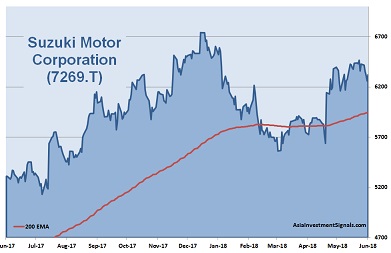 Suzuki Motor Corporation (7269.T) is one of the top ten car manufacturers in the world and the second most profitable carmaker after BMW. Suzuki is known as a specialist for smaller cars. Besides the automobile business, which accounts for more than 90 percent of the total revenues and grew by almost 20 percent last year, Suzuki Motor is also engaged in two further segments.[mepr-active membership=”1734″ ifallowed=”show” unauth=”message” unauth_message=”Please login or purchase a membership to view full text.”] The motorcycle business accounted for 7 percent of the revenues and increased by 19 percent last year. Marine and other products accounted for only 2 percent but grew by 11 percent last year. Some of the growth was due to a weakening Yen. Sales volume of automobiles and motorcycles rose by 11 and 16 percent respectively due to strong demand in India and Indonesia.
Suzuki Motor Corporation (7269.T) is one of the top ten car manufacturers in the world and the second most profitable carmaker after BMW. Suzuki is known as a specialist for smaller cars. Besides the automobile business, which accounts for more than 90 percent of the total revenues and grew by almost 20 percent last year, Suzuki Motor is also engaged in two further segments.[mepr-active membership=”1734″ ifallowed=”show” unauth=”message” unauth_message=”Please login or purchase a membership to view full text.”] The motorcycle business accounted for 7 percent of the revenues and increased by 19 percent last year. Marine and other products accounted for only 2 percent but grew by 11 percent last year. Some of the growth was due to a weakening Yen. Sales volume of automobiles and motorcycles rose by 11 and 16 percent respectively due to strong demand in India and Indonesia.
Suzuki Motor has recently announced to stop car production in China due to sluggish sales of its compact cars there. The company is going to focus its resources on India, where it has already a market share of more than 50 percent and which is set to become the third-largest car market in the world. Suzuki Motor runs already three factories in India and has reached the mark of 20m sold cars. A partnership with Toyota is in discussion to sell each other’s cars in India and to collaborate in areas such as electric vehicles and autonomous driving. The goal is to introduce a joint developed electric car in India by 2020. The partnership could also be the base to tap into Africa and other global markets.
India is the largest geographic market of Suzuki Motor, accounting for more than a third of the revenue. Japan came second with around 30 percent of the revenues, followed by Europe with 14 percent, and other Asian countries with 12 percent. Suzuki Motor experienced growth especially in India, Asia (ex-Japan), and Europe with rates between 20 and 30 percent last year. After record high sales and income last year, Suzuki Motor expects only slightly higher sales of 1.1 percent for the ongoing year and lower earnings due to a stronger Yen and increased R&D spending. The company forecasts sales volume for its automobiles and motorcycles to grow by 2 and 4 percent respectively.
Suzuki Motor was founded in 1909 and is headquartered in Hamamatsu, Japan. The shares are listed on Tokyo’s stock exchanges since 1949. The company’s shares can also be traded in Germany and the US. Major shareholder is The Master Trust Bank of Japan with an ownership of around 8 percent, followed by Japan Trustee Services Bank with an ownership of about 5 percent. Almost 90 percent of the shares are in public hand.
With a workforce of over 65,000 employees, Suzuki Motor reported revenues of 3,757bn JPY (34bn USD) and profits before tax of 384bn JPY (3.5bn USD) in its fiscal year 2017/18. This is an increase of 19 and 30 percent respectively compared to the same period a year ago. In 2016/17, revenues remained almost flat while profits increased by 20 percent. The operating margin of 8 percent is below industry average. Suzuki Motor’s cash reserves slightly reduced by 2 percent to 601bn JPY (5.5bn USD) at the end of March 2018. The company shows a stable balance sheet with good profitability and financial strength. The equity ratio is at 48 percent and the gearing, defined here as total liabilities to total equity, at 107 percent. R&I’s current rating of Suzuki Motor is A (3rd highest rate) with a stable outlook. Next results will be announced in early August.
Suzuki Motor’s shares are in an uptrend since July 2016 and gained around 140 percent in value since. The shares lost about 4 percent this year. The company is priced at 13 times earnings. The shares trade two times book value and at seven times cash flow. The latest dividend yielded about one percent only. The majority of covering analysts rate the stock as an outperformer.
Our Conclusion: Suzuki Motor shows robust financial position with good profitability and financial strength. The valuation is relatively low compared to its peers. The industry outlook is positive for the ongoing year. Asia’s auto market is supposed to grow by almost 5 percent in 2018 with sales in South Asia (India, etc.) projected to increase by even more than 9 percent.
Suzuki Motor has a strong expertise in compact cars and is well positioned in an intensely competitive environment. Revenues and profits grew annually by 12 and 24 percent respectively over the last five years. Assuming a stable global economy, Suzuki Motor’s forecast could turn out as much too conservative. With only 2 percent of the revenues generated in the US, the company is hardly affected by any US tariff disputes. We expect Suzuki Motor’s share price to increase by around 10 to 15 percent over the next 12 months.
AIS Rating: ★★★★☆
| 2012/13 | 2013/14 | 2014/15 | 2015/16 | 2016/17 | 2017/18 | |
|---|---|---|---|---|---|---|
| EPS (JPY) | 132 | 192 | 173 | 235 | 362 | 474 |
| Change | 49% | 45% | -10% | 36% | 54% | 31% |
| P/E | P/E SECTOR |
P/B | P/CF | Equity Ratio* |
ROE | LIAB./ Equity** |
Div YLD |
|---|---|---|---|---|---|---|---|
| 13 | 19 | 2.1 | 7 | 48% | 18% | 107% | 1.2% |
* Equity / Total Assets, ** Total Liabilities / Equity
[/mepr-active]
